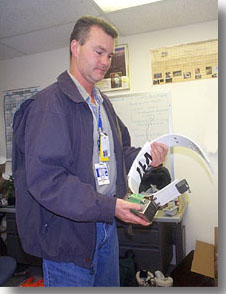
James Biggs of Ecology (ESH-20) displays one of the collars used for monitoring the movement of elk. A Global Positioning System device, used to track animals in the wild, is attached to the collar. Using this equipment, scientists can predict how movement patterns of a species will change over time. Each collar cost about $3,000 and is reusable. Photo by Michael Carlson, Public Affairs
Using Global Positioning System technology, Laboratory researchers are gaining new insight in to how and where wildlife roam. By tracking animals in the wild, biologists can predict how movement patterns of species will change over time. Data from tracking projects also can help biologists alleviate hazards associated with the movement of elk and observe population trends of wild species, James Biggs of Ecology (ESH-20) said.
Biggs said wildlife managers can use the data to identify areas where elk and deer are most likely to cross busy roads, creating areas of potentially hazardous interactions between humans and animals. Researchers also can incorporate these data into developing warning devices that will alert drivers of elk and deer crossing.
Movements of animals across busy Lab-owned roadways are responsible for an estimated $250,000 a year in vehicle damage, lost work time, emergency response and injuries. Fifty to 60 accidents are estimated to happen annually in the Los Alamos area because of these animal movements.
Biggs said drivers can minimize their chances of a collision with deer and elk by taking certain precautions. He said if you see a deer or elk on the side of the road, there may be another one nearby that is ready to cross, so be particularly aware of your surroundings. Flash lights to warn other drivers of animals crossing and drive 5 to 10 miles an hour slower than the posted limit during times when animals may be more active and moving around.
Tracking information also is useful for monitoring the effects of the Cerro Grande Fire on wild species. Elk are expected to return to areas hit hard by the devastating blaze because of new growth of shrub, grasses, aspen and other plant life, Biggs said.
"Plants tend to be higher in nutrient quality after a fire," Biggs said. He said elk will be more attracted to fire-scarred areas because of the potential for higher quality and quantity of food items, and it often takes a few years for wildlife to adjust to new feeding places.
The Lab is working closely with the National Park Service, New Mexico Department of Game and Fish as well as the U.S. Forest Service to trap and collar wildlife in the region, Biggs said. A project to collar elk was completed last year. He said efforts to collar additional elk near the fire area are in planning stages. Each GPS collar costs about $3,000 and is programmed to fall off the animal at a predetermined time. Because the collars are equipped with beacons, researchers can retrieve the units and reuse them.
By attaching GPS receivers to animal collars, rather than the conventional VHF radio devices, researchers can monitor the movements of wild animals over a wider area for a longer period, collect a dramatically greater amount of data and obtain more accurate data.
